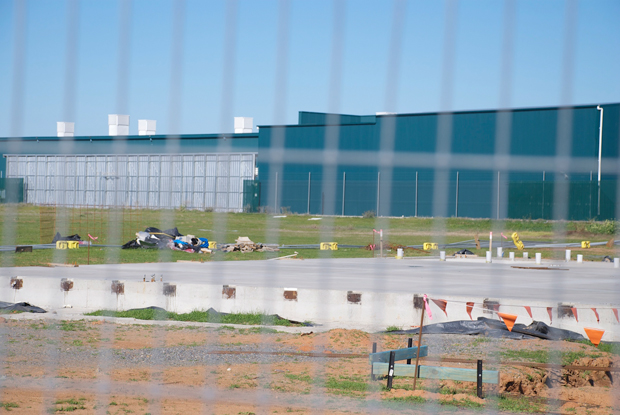Nasim Gulzari has made the most of his new life. Since arriving in Australia by boat in the late 1990s, the 49-year-old Afghan refugee has built three houses, lived and worked in three different states and, along with his wife, is in the process of raising five children.
It is the first day of Ramadan when we meet in his home in a suburban area of Shepparton.
“I am sorry that I cannot offer you any food,” he says graciously.
For our interview, Gulzari has invited a number of other recently arrived Afghans to share their stories: Mohsin, a 23-year-old who has only been in Australia for a week, Abbas, 26 and Nuri, 47. We take our positions on a large, ornate rug in Gulzari’s lounge room, overlooking the backyard. Outside, a hills hoist is affixed with earthen-coloured garments, and children run around happily with an Australian rules football.
“The Afghan people are hard working, very friendly people,” says Gulzari.
“We have made a lot of friends in the community.”
***
Arriving in Shepparton in 2009, Gulzari is part of a growing Afghan contingent in the Goulburn Valley region.
According to the 2011 Census, there are 557 Afghans living in the Greater Shepparton district, however the Ethnic Council of Shepparton estimates actual numbers to be as high as 1200.
The region is also thought to house the second largest population of Afghans in Victoria, after Dandenong.
Like most Afghan migrants in Australia, Gulzari is an ethnic Hazara – a persecuted Shia Muslim minority originating from central Afghanistan. His path to Australia was precipitated by the Taliban’s taking control over his native village in 1998.
“We escaped from our country because of the extremists…and I believe our people paid the biggest price,” he tells New Matilda.
“It is … genocide, they’re killing in groups, like collective punishment, they don’t care [whether]it’s women or children. It’s a very, very bad situation.”
In fear of he and his family’s safety, Gulzari travelled to Pakistan on a fake passport, before arriving in Indonesia and boarding a boat, along with nine other asylum seekers, for Australia.
“At that time it was a little bit easier,” he says.
Gulzari received a Permanent Protection Visa on 15 August 1999, after spending six weeks in Port Hedland detention centre. He soon set about building a life in Australia, finding work in an abattoir in Albany, on the Western Australia coast, and in 2003 sponsored his wife and three children to migrate to Australia.
Had he arrived in the country much later, Gulzari would not have had the same opportunities. Around two months after he received permanent residency, John Howard’s Coalition government introduced Temporary Protection Visas (TPVs). Part of a new hardline approach to asylum seekers, TPVs were granted to refugees for a period of three years, after which time they would have to re-apply for refugee status. The new provisions also barred refugees from sponsoring the passage of family members, and limited their access to basic resettlement services, employment programs and English classes.
The language lessons Gulzari received upon arriving in Australia have set him on his career path. Currently, he provides interpreting services through Centrelink for newly arrived Afghans, and is mid-way through a Diploma of Interpreting at RMIT. When he graduates, he hopes to enter the health and legal fields in order to better serve the local Afghan community.
While it appears that Gulzari has settled well into life in a new country, there is a lingering sense of nostalgia for the home he left behind.
“If Aghanistan had been safe we wouldn’t have come to Australia,” he says matter-of-factly.
***
“The Government just doesn’t understand how [policy]impacts so specifically on individuals,” Chris Hazelman, Manager of the Ethnic Council of Shepparton tells New Matilda. Having supported new arrivals in the Greater Shepparton region for nearly 10 years, Hazelman has witnessed first-hand the effects of the Government’s approach to asylum seekers.
He sees parallels with today’s asylum seekers and those who were granted TPVs under the Howard government, recalling how many Iraqi refugees became “institutionalised not to work”.
“We’re making the same mistake again. We’re going to create another subclass of these people,” he says.
The Government’s “no advantage” approach to asylum seekers in many ways goes beyond the restrictions placed on TPV holders. Under this policy, which lasted until the Rudd Government’s PNG announcement on 19 July, any asylum seeker who has arrived in Australia by boat since 13 August 2012 is either relocated to Nauru or Manus Island, or released into the community on a bridging visa while their asylum claim is processed.
While the government’s new policy will see all asylum seekers arriving by boat transported to Papua New Guinea, and never settled in Australia, many who arrived under the previous regime remain in a state of limbo.
As at June this year, 19,000 asylum seekers were waiting to be processed under the “no advantage” policy.
Furthermore, those who have been granted bridging visas are not only denied basic accommodation and most Centrelink entitlements (some are eligible to receive 89 per cent of the Newstart allowance for a period of six weeks), but are also unable to work.
“It is ludicrous,” says Hazelman.
“The ability to work is a key determinant of people’s health.”
It is a view shared by Lorna Gillespie, a community development worker with UnitingCare Cutting Edge.
“We have at the moment a large group of people who aren’t allowed to work, and that’s going to create a huge problem,” she told New Matilda, in reference to those on bridging visas.
“The issue is that we can’t provide hope, because we don’t know what’s going to happen. Not being able to provide hope is extremely daunting as a worker.”
***
Nuri sits on the edge of our circle with downcast eyes. Arriving in Australia earlier this year, the 47 year-old Hazara was granted a bridging visa and relocated to Melbourne to live with some friends.
“He lives in an uncertain situation,” says Gulzari, interpreting for Nuri. He explains how his friend has been waiting for three months for an outcome from DIAC, with no indication of when his claim will be processed. With family still in Afghanistan, and an inability to plan for the future, a sense of anguish appears evident in Nuri’s demeanor.
Despite the emotional and psychological challenges that many refugees face on arrival in Australia, the Afghan community has shown itself to be highly resilient and adaptable to a new environment. In Shepparton, this is now being embodied in the construction of an Afghani mosque.
Funded entirely with community contributions totaling around $1 million, the mosque will provide an important meeting place for Afghans in the region.
“We are a new people, we don’t have a home or a community centre,” says Gulzari.
“We have to build our own place.”
|
Shepparton mosque building site. Photo by Dylan Bird. |
Local Afghani residents have also, in consultation with Greater Shepparton City Council, managed to secure a separate Muslim burial site to cater to their cultural traditions.
Gulzari gives some clues as to why Afghans have managed to settle so successfully in the Goulburn Valley.
“We have a custom that [other Afghans]can come and stay in our house for one or two months, we can help them find a job and enroll them in English classes,” he says, stressing the inextricable bond that Hazaras have with one another.
Cultural ties alone do not account for the success of Afghan resettlement, however.
“They work bloody hard,” says Hazelman.
“They’re not drinking, they’re not gambling, and they’re quite happy to put money into the community.”
Along with housing affordability and a disposition to a rural lifestyle, Gulzari cites work opportunities as one of the key factors attracting Afghan refugees to the Goulburn Valley.
This often includes seasonal work in the many orchards throughout the region, however there is an indication that other employment options are beginning to arise.
Abbas Naseri, for example, works as a driving instructor in the Shepparton region. After receiving permanent residency in 2009, following a three-month stint at Christmas Island detention centre, he spent time in Mildura, Batlow and Rockhampton, working variously as a fruit picker, construction worker and meat processor. After obtaining his drivers’ license in Melbourne, he came to Shepparton on a friend’s recommendation, and found it to be a quieter and more amenable place to put his skills to use. Soon after arriving, he established a driving school, which has become an important resource for other Afghanis in the area.
However, Naseri does not necessarily see his future in the Goulburn Valley township.
“I plan to move to Melbourne next December. I want to start uni in 2014 … to study either psychology or law,” he says assuredly.
“It doesn’t matter how long it takes. Five years, seven years, it doesn’t matter.”
***
Under the new PNG asylum seeker policy, neither Gulzari, Nuri nor Naseri would be allowed to settle in Australia. The case is different for Mohsin. After waiting for two years in Indonesia, the 23 year-old Hazara was eventually granted permanent residency by DIAC after being referred by the UNHCR. Upon entering Australia, he was transferred to an address in Shepparton to reunite with family and friends from his village in Afghanistan.
Following the report of the Houston Panel on Asylum Seekers in 2012, the Government doubled the offshore resettlement program to 12,000 places annually, and raised the total humanitarian intake to 20,000. Theoretically this should result in more people in Mohsin’s situation finding a passage to Australia.
However, the reality of humanitarian resettlement is far from orderly. According to a 2011 government report, there is no time-specific determination of asylum seekers’ resettlement into a host nation. As such, the report says, any notion of a queue is misleading, with refugees being selected for resettlement based on individual needs. Furthermore, the UNHCR reports that only around one third of the 10.5 million refugees worldwide are based in camps, and that programs in resettlement states can only ever cater for approximately 10 per cent of asylum seekers in need of relocation. These factors combine to make resettlement efforts inherently complex and time-consuming.
***
“There are a lot of people waiting in different parts of Indonesia” for an outcome on their claim, says Mohsin, explaining his passage to Australia.
Like many of the asylum seekers in the South Asian nation, Mohsin moved around to a number of different locations in search of work and a secure environment. With a lack of domestic legal safeguards, however, many of those in his situation risk being arrested as illegal immigrants.
Mohsin hesitates when asked about his immediate future.
“My plan is to study,” he begins, “[but]first I need to improve my English.”
“This town is not too crowded, there are more opportunities, and I can improve my life … I think I might stay here.
“I am so glad to have come to Australia, and to Shepparton.”
Gulzari nods encouragingly in Mohsin’s direction. Sitting in his modest red brick home among a circle of friends and countrymen, he appears quietly content with the life he has established in Shepparton – not only for he and his family, but also for the many other Afghan refugees who have come since.
With a reassuring smile, he emphasises the health of the local Afghan community.
“We are very happy.”
Donate To New Matilda
New Matilda is a small, independent media outlet. We survive through reader contributions, and never losing a lawsuit. If you got something from this article, giving something back helps us to continue speaking truth to power. Every little bit counts.




